VLSFO's - the black carbon debate?
By Steve Bee, VPS Group Commercial & Business Development Director
Black Carbon is material produced and emitted as solid particulate matter from the incomplete combustion of carbon‐based fuels. Black carbon can have a detrimental effect on human health, contribute to environmental warming effects and it has been quoted that black carbon emissions from global shipping contributes 1‐2% of the world’s black carbon pollution.
Before looking into the possible contribution to black carbon emissions from fuels, a more significant factor relates to the engine type and load, impacting upon this form and level of pollution. Slow speed two‐stroke engines, used in larger oceangoing vessels are considered to have lower Black Carbon emission factors than higher speed four stroke engines. For larger engines, increasing engine load, reduces Black Carbon emissions whereas for smaller engines, the reverse relationship seems to hold. Across a variety of diesel engine types, larger engine displacement correlates with lower relative Black Carbon emissions. The Tier II engine, ie more modern marine engines with electronic controls and in‐cylinder approaches to reduce NOx emissions have lower Black Carbon emissions. Scrubbers installed to meet IMO2020 also provide an approximate 30% reduction in Black Carbon emissions.
Focusing now upon marine fuels, Heavy Fuel Oils (HFO), typically contain approximately 60% aromatics, and tend to be high in density. Within HFO, these aromatic hydrocarbons possess a much higher specific gravity than other hydrocarbons and are very stable under heat, but can be chemically active to a degree. These aromatic compounds contain a higher proportion of carbon than the other hydrocarbon types and due to this characteristic, they have a tendency to smoke, when burnt.
Recently industry and shipping media reports have stated the new VLSFO fuels introduced to ensure legislative compliance to 0.50% sulphur content are responsible, or potentially responsible, for increased levels of black carbon pollution due to their higher aromatic content?
Whilst its possible certain VLSFOs may have elevated aromatic content, it is to be expected that for VLSFO fuels produced by blending, such fuels will have lower aromatic content than a typical Heavy Fuel Oil (HFO) since the major blended component (distillate) has typically half the aromatic content:

The table above shows an average VLSFO composition where the aromatic content is less than 50% of the aromatic content seen within a typical HFO. However, the saturate content of an average VLSFO fuel is three times that of a typical HFO. Saturates are present in the form of paraffinic components, which can lead to issues in relation fuel wax precipitation and VLSFOs typically have saturate levels similar to distillate fuels.
However as stated, with a number of blended VLSFOs potentially having less than half the aromatic content of HFO, it is difficult to understand why it is believed by some, that all VLSFOs may be producing more black carbon due to their aromatic content?
Taking another look at VLSFOs tested by VPS in Q4‐2019, we can also consider:
Micro Carbon Residue (MCR): The carbon residue value serves as an approximation of the tendency of petroleum products to form carbonaceous deposits under similar degradation conditions and may be useful in the assessment of relative carbon‐forming tendencies of products within the same class. In this case, care should be taken in the interpretation of results (ISO 10370:2014).
Calculated Carbon Aromaticity Index (CCAI): An index of the ignition quality of residual fuel oil, based on its density and kinematic viscosity. The lower the CCAI, the less aromatic the fuel. It is recognized that over the years since its development, the chemistry of residual fuel oil blends has become more complex and today, on occasions, fuels with similar densities and viscosities (i.e. similar CCAI’s) may have significantly different ignition characteristics as may fuels of similar CCAI values but of different densities and viscosities (CIMAC, 2011).
The figure below provides a comparison of the average MCR and CCAI values for all VPS tested HSFO and VLSFO samples in Q4‐2019. It illustrates that both MCR and CCAI are much lower for VLSFOs than for HSFOs, which means that these VLSFOs tested, could have lower potential for black carbon emissions than HSFOs.

Blending Light Cycle Gas Oils (LCOs) in VLSFOs: One key point to highlight is, there may well be a percentage of VLSFOs which contain light cycle gas oils (LCOs) within the blend, (LCOs). LCOs can contain up to 60% aromatics and as a consequence, any VLSFO blended with LCOs may firstly have a higher density, than other VLSFOs, due to the higher aromatic content of LCOs, but their potential for producing black carbon will be on par with HFOs of similar aromatic content.
 Search
Search
 Customer
Customer